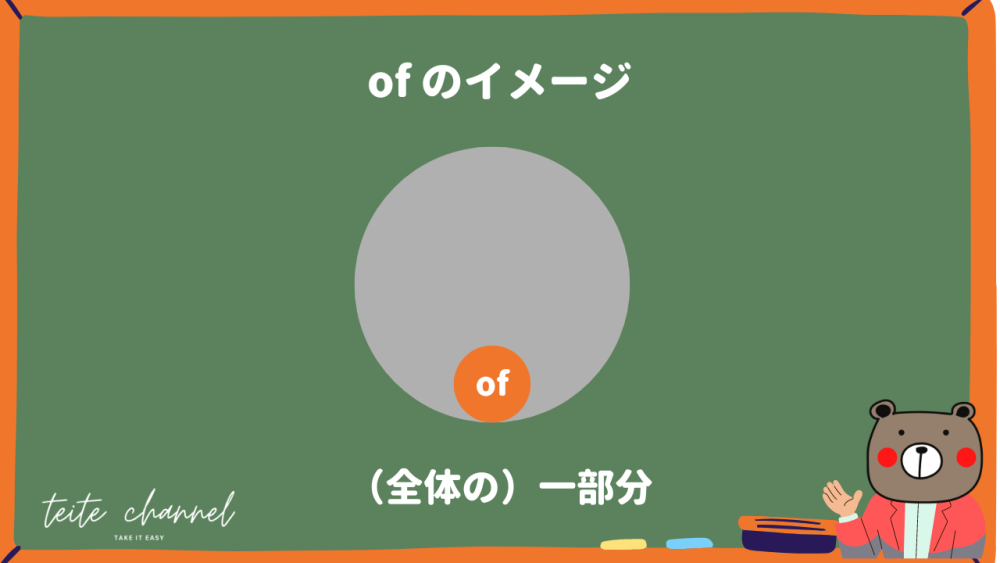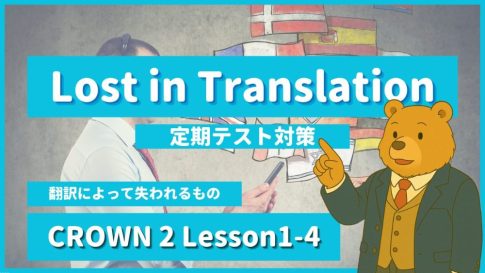▼音声で学びたい方はこちらへ🐻
現在撮影中

▼CROWN2-高2《Lesson1》はこちらから🐻
- 授業前にひとこと
- 勉強のポイント
- 本文&和訳
- 重要単語
- 重要ポイント
- 【1】Now, let me tell you about a personal experience.
- 【2】When I was a student in Kyoto, I often visited temples and shrines.
- 【3】I was wondering what makes Japanese gardens attractive.
- 【4】I remembered being told that the essence of Japanese gardens is wabi-sabi.
- 【5】I didn’t know what exactly this expression meant, so I consulted my dictionary.
- 【6】Wabi-sabi was defined as “elegant simplicity.”
- 【7】And a more detailed explanation followed:
- 【8】“Wabi and sabi are the highest aesthetic values in traditional Japanese arts.
- 【9】They refer to a sense of quiet sadness and the encouragement of simplicity.”
- 【10】I felt like I was lost in a deep cloud.
- 【11】The concept was too complex for me to understand.
- 【12】But years later, as I sat on the wooden veranda of a temple, looking out at the garden, I thought I finally had a sense of wabi-sabi.
- 【13】This episode shows that it is often very difficult, if not impossible, to translate some concepts from one language into another.
- 【14】This is true not only for an abstract concept, but also for commonly used expressions in Japanese.
- 【15】How about mottainai, shikataganai, otsukaresama, itadakimasu, and itsumo osewa ni natteimasu?
- 【16】See if you can find equivalent expressions in English, or ask your bilingual friends if they are around.
授業前にひとこと
今回は、CROWN2-高2《Lesson1》について扱っていきます❗️
Lesson1のタイトルは…🐻
Lost in Translation
という「翻訳に関する問題」についてのお話です。
ちなみに、このLessonでメインで使われている文法事項は…
不定詞の意味上の主語 / 不定詞の受け身 / 動名詞の受け身
です❗️
ちなみに、この記事では…
CROWN
の本文を引用しています。
すでに上記の教科書をお持ちの方向けの記事になりますので、お持ちでない方は全国の『教科書取扱書店』にて購入してから、記事を読み進めるようにお願いします!
さて、いつも授業前に説明することですが…
⇧に載せてあります『単語・和訳・英作文トレーニング』をテスト1週間前から毎日やってみてください❗️曖昧な理解がなくなり、成績が爆伸びします!!
コミュ英以外の定期テスト対策は?
現代文の定期テスト対策は こちら から
古文の定期テスト対策は こちら から
漢文の定期テスト対策は こちら から


個別指導塾 SECOND《定期テストコース》 をもっと活用する


▷ 解説記事のリクエスト
▷ 新着情報のキャッチ
▷ 定期テスト予想問題
▷ オリジナルグッズの購入
ができるようになっています🐻
個別指導塾 SECOND《定期テストコース》 の 公式LINEアカウント はこちら
勉強のポイント
①本文は『ある概念を別の言語に翻訳することが非常に難しい』ことを説明しているシーンだと理解する。
②単語・重要ポイントをインプットする。
③不定詞の意味上の主語 / 不定詞の受け身 / 動名詞の受け身 について理解する。
本文&和訳
本文(Scene2)
【2】Now, let me tell you about a personal experience.
さて、個人的な経験をお話ししましょう。
When I was a student in Kyoto, I often visited temples and shrines.
京都で学生だった頃、よく寺社仏閣を訪れていました。
I was wondering what makes Japanese gardens attractive.
日本庭園の魅力は何だろうと考えていました。
I remembered being told that the essence of Japanese gardens is wabi-sabi.
日本庭園の真髄は侘び寂びだと言われたことを思い出しました。
I didn’t know what exactly this expression meant, so I consulted my dictionary.
この言葉の意味が分からなかったので、辞書を引いてみました。
Wabi-sabi was defined as “elegant simplicity.”
侘び寂びとは「上品な簡素さ」と定義されていました。
And a more detailed explanation followed:
そして、さらに詳しい説明が続きました。
“Wabi and sabi are the highest aesthetic values in traditional Japanese arts.
「侘びと寂びは、日本の伝統芸術における最高の美的価値である。
They refer to a sense of quiet sadness and the encouragement of simplicity.”
静かな悲しみと簡素さの奨励を指す。」と。
I felt like I was lost in a deep cloud.
まるで深い雲の中に迷い込んだような気がしました。
The concept was too complex for me to understand.
その概念は私には複雑すぎて理解できませんでした。
But years later, as I sat on the wooden veranda of a temple, looking out at the garden, I thought I finally had a sense of wabi-sabi.
しかし、何年も経って、ある寺院の木造の縁側に座って庭を眺めていたとき、ついに侘び寂びの感覚を理解できたような気がしました。
This episode shows that it is often very difficult, if not impossible, to translate some concepts from one language into another.
このエピソードは、ある概念をある言語から別の言語に翻訳することが、不可能ではないにしても、非常に難しいことが多いことを示しています。
This is true not only for an abstract concept, but also for commonly used expressions in Japanese.
これは抽象的な概念だけでなく、日本語でよく使われる表現にも当てはまります。
How about mottainai, shikataganai, otsukaresama, itadakimasu, and itsumo osewa ni natteimasu?
「もったいない」「仕方がない」「お疲れ様」「いただきます」「いつもお世話になります」などはいかがでしょうか?
See if you can find equivalent expressions in English, or ask your bilingual friends if they are around.
英語で同等の表現がないか探してみたり、バイリンガルの友達が近くにいたら聞いてみたりしてみてください。
重要単語


V : 動詞 , Ving : 動名詞 , Vpp : 過去分詞, O:目的語, C:補語
| attractive | 魅力的な |
| essence | 本質 |
| consult | 相談する |
| elegant | 優雅な |
| simplicity | 単純さ・簡潔さ |
| detailed | 詳細な |
| explanation | 説明 |
| aesthetic | 美的な |
| concept | 概念 |
| complex | 複雑な |
| veranda | ベランダ |
| impossible | 不可能な |
| abstract | 抽象的な |
| equivalent | 同等の |
| define A as B | AをBと定義する |
| look out at A | Aを眺める |
| if not impossible | 不可能ではないにしても |
| a sense of A | Aの感覚( = a feeling of A ) |
重要ポイント


「ピンク」=重要ポイント
▼記号について
V : 動詞 Ving : 動名詞 Vpp : 過去分詞
【 】名詞句・節 〈 〉形容詞句・節 ( )副詞句・節
S:主語 O:目的語 C:補語 M:副詞
【1】Now, let me tell you about a personal experience.
《和訳》
さて、個人的な経験をお話ししましょう。
《重要ポイント》
「Now, 」= さて、
・副詞 “Now” が使用されています。
・話し手が話題を切り替えるときや注意を引くときに使われる。
・文頭に置かれ、軽い間を示すためにカンマで区切られるのが一般的。
「let me tell」= 私に伝えさせて
・命令文 “Let me ~” の構文 が使われています。
・「私に〜させてください」という丁寧な申し出や導入表現。
・”let + 人 + 動詞の原形” という形で使います。
「tell you about a personal experience」= あなたに個人的な経験について伝える
・”tell 人 about 物” の形で、「人に〜について話す」
・人 = you, 物 = a personal experience
・不定冠詞 “a” が使用されていて、「ある〜」という意味。
・つまり、”a personal experience” 、「(ある)一つの個人的な経験」という意味。
【2】When I was a student in Kyoto, I often visited temples and shrines.
《和訳》
京都で学生だった頃、よく寺社仏閣を訪れていました。
《重要ポイント》
「I often visited temples and shrines」= よく寺社仏閣を訪れていました
・頻度副詞 “often” の位置 について注意。
・頻度副詞は通常、一般動詞の前に置かれます!
・”temples and shrines” は visited の目的語で、”and” によって2つの名詞が並列されている。
・「寺と神社」つまり、「寺社仏閣」と訳しています。
【3】I was wondering what makes Japanese gardens attractive.
《和訳》
日本庭園の魅力は何だろうと考えていました。
《重要ポイント》
「I was wondering」= 〜と考えていました
・「〜かと思っていた/〜について考えていた」という意味で、よく使う表現。
「what makes Japanese gardens attractive」= 何が日本庭園を魅力的にするのか
・直訳は「何が日本庭園を魅力的にするのか」でOK。
・つまり、「日本庭園の魅力は何か」とここでは訳しています。
・疑問詞が文中に入り、間接疑問文として使われています。
・主語 “what” が単数扱いのため、動詞 “make” は三人称単数の “makes” に変化している。
・”makes A B” の構文(使役動詞)で、「AをBにする」という意味。
・A = Japanese gardens, B = attractive つまり、Japanese gardens を attractive にするということ。
【4】I remembered being told that the essence of Japanese gardens is wabi-sabi.
《和訳》
日本庭園の真髄は侘び寂びだと言われたことを思い出しました。
《重要ポイント》
「I remembered being told ~ 」= ~と言われたことを思い出した。
・動名詞句 “being told” をチェック!
・受動態の動名詞『being Vpp』の形で、『〜されること』という意味。
・動詞 “remember” の使い方(remember + 動名詞)にも注意。
・”remember” の後に動名詞(Ving)が来ると「(過去に)〜したことを覚えている」という意味になる。
・ちなみに、”remember” の後に不定詞(to V)が来ると「(これから)〜することを覚えている」という意味。
「that the essence of Japanese gardens is wabi-sabi.」= 日本庭園の真髄は侘び寂びだと
・”that the essence of Japanese gardens is wabi-sabi” は “being told” の内容を説明する名詞節。つまり、言われた内容がこの that節内に書かれています。
・that は省略可能。
・of は全体の一部分のイメージ。下のポイント解説でチェック!


ここまで執筆完了❗️日々解説を加えていきます!


個別指導塾 SECOND《定期テストコース》 の 公式LINEアカウント はこちら
【5】I didn’t know what exactly this expression meant, so I consulted my dictionary.
《和訳》
この言葉の意味が分からなかったので、辞書を引いてみました。
《重要ポイント》
【6】Wabi-sabi was defined as “elegant simplicity.”
《和訳》
侘び寂びとは「上品な簡素さ」と定義されていました。
《重要ポイント》
【7】And a more detailed explanation followed:
《和訳》
そして、さらに詳しい説明が続きました。
《重要ポイント》
【8】“Wabi and sabi are the highest aesthetic values in traditional Japanese arts.
《和訳》
「侘びと寂びは、日本の伝統芸術における最高の美的価値である。
《重要ポイント》
【9】They refer to a sense of quiet sadness and the encouragement of simplicity.”
《和訳》
静かな悲しみと簡素さの奨励を指す。」と。
《重要ポイント》
【10】I felt like I was lost in a deep cloud.
《和訳》
まるで深い雲の中に迷い込んだような気がしました。
《重要ポイント》
【11】The concept was too complex for me to understand.
《和訳》
その概念は私には複雑すぎて理解できませんでした。
《重要ポイント》
【12】But years later, as I sat on the wooden veranda of a temple, looking out at the garden, I thought I finally had a sense of wabi-sabi.
《和訳》
しかし、何年も経って、ある寺院の木造の縁側に座って庭を眺めていたとき、ついに侘び寂びの感覚を理解できたような気がしました。
《重要ポイント》
【13】This episode shows that it is often very difficult, if not impossible, to translate some concepts from one language into another.
《和訳》
このエピソードは、ある概念をある言語から別の言語に翻訳することが、不可能ではないにしても、非常に難しいことが多いことを示しています。
《重要ポイント》
【14】This is true not only for an abstract concept, but also for commonly used expressions in Japanese.
《和訳》
これは抽象的な概念だけでなく、日本語でよく使われる表現にも当てはまります。
《重要ポイント》
【15】How about mottainai, shikataganai, otsukaresama, itadakimasu, and itsumo osewa ni natteimasu?
《和訳》
「もったいない」「仕方がない」「お疲れ様」「いただきます」「いつもお世話になります」などはいかがでしょうか?
《重要ポイント》
【16】See if you can find equivalent expressions in English, or ask your bilingual friends if they are around.
《和訳》
英語で同等の表現がないか探してみたり、バイリンガルの友達が近くにいたら聞いてみたりしてみてください。
《重要ポイント》


これで全て終了です❗️
「CROWN2-高2《Lesson1-2 | Lost in Translation 》」おつかれさまでした🐻
不定詞の意味上の主語 / 不定詞の受け身 / 動名詞の受け身 を踏まえて読解すれば、比較的話しの流れは掴みやすいですが、それが出来ていないと苦戦している文章もあったのではないでしょうか❗️
理解出来ている人も、油断せずに復習&音読するのをお忘れなく!!
①授業前にひとこと、でも話しましたが…
⇧に載せてあります『単語・和訳・英作文トレーニング』をテスト1週間前から毎日やってみてください❗️曖昧な理解がなくなり、成績が爆伸びします!!
最後まで見てくださってありがとうございました!
またお会いしましょう!定期テストがんばれ〜🐻
じゃあね〜、バイバイ!!
















